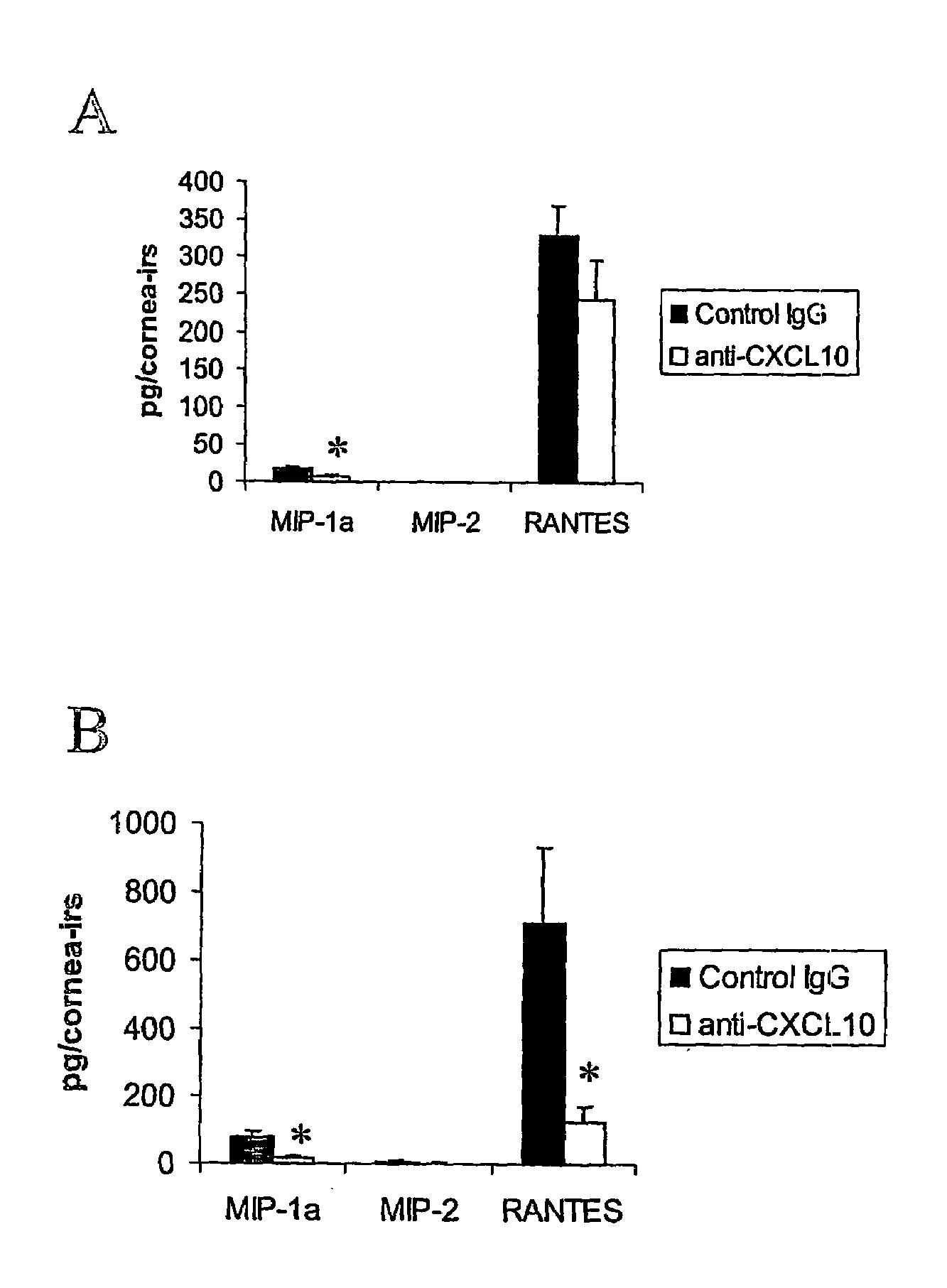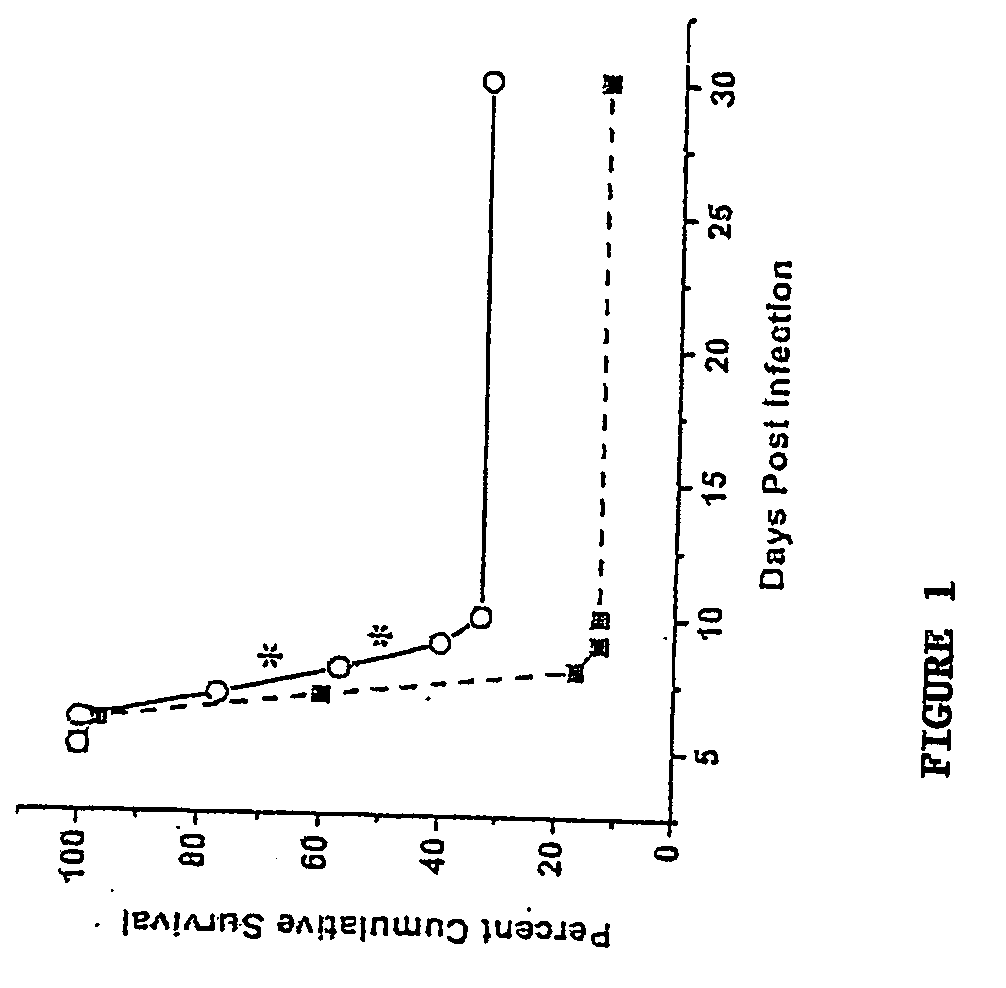Methods for Treating Ocular Inflammation by Neutralizing Cxcl10 Activity
a technology of cxcl10 and activity, applied in the field of ocular inflammation by neutralizing cxcl10 activity, can solve the problems of corneal scars, permanent loss of vision, even blindness, etc., and achieve the effect of reducing corneal inflammation and reducing ocular inflammation
- Summary
- Abstract
- Description
- Claims
- Application Information
AI Technical Summary
Benefits of technology
Problems solved by technology
Method used
Image
Examples
example i
Neutralization of CXCL10 Prolongs Survival of HSV-1-Infected Animals
[0103]This example shows that neutralizing CXCL10 in HSV-1-infected animals prolongs survival.
[0104]To determine the effect of neutralizing CXCL10 on survival of HSV-1-infected animals, mice (n=30 / group) were infected with HSV-1 (300 pfu / eye) and inoculated with 100 μg of anti-CXCL10 IgG or control IgG at time 0 and 2 and 5 days post infection. Specifically, Female ICR mice (25-30 grams, Harlan Sprague-Dawley, Indianapolis, Ind.) were anesthetized by injection with 0.1 ml of PBS containing xylazine (2 mg / ml; 6.6 mg / kg) and ketamine (30 mg / ml; 100 mg / kg) i.p. Corneas were scarified with a 25-gauge needle, and tear film was blotted with tissue before inoculating with 300 plaque forming units (pfu) / eye HSV-1. At the time of infection and 2 and 5 days post infection, mice received 100 μg anti-CXCL10 IgG or control IgG i.p. Mice were either monitored for cumulative survival over 30 days post infection (p.i.) or euthanize...
example ii
Neutralization of CXCL10 Reduces Ocular Pathology in HSV-1-Infected Animals
[0109]This example shows that neutralizing CXCL10 in HSV-1-infected animals reduces infiltration of leukocytes into the corneal stroma, ciliary body and iris.
[0110]To determine the effect of neutralizing CXCL10 on ocular pathology, mice (n=8 / group) were infected with HSV-1 (300 pfu / eye) and inoculated with 100 μg of anti-CXCL10 IgG or control IgG at time 0 and 2 and 5 days post infection. At day 6 p.i., the mice were euthanized and the eyes were removed and processed for hematoxylin-eosin staining. In FIG. 2A, a representative anti-CXCL10 Ab-treated mouse eye section is shown at 40× magnification; structures are labeled as follows: C is cornea; I is iris, and CB is ciliary body. In FIG. 2B, a representative control Ab-treated mouse eye section is show at 40× magnification; structures are labeled the same as in FIG. 2A. Insets for FIGS. 2A and 2B depict ciliary body and stroma at 400× magnification.
[0111]HSV-1...
example iii
Neutralization of CXCL10 Enhances HSV-1 Replication but Hinders HSV-1 Trafficking to the Retina
[0121]This example shows that neutralizing CXCL10 in HSV-1-infected animals hinders HSV-1 spread to the retina.
[0122]As described herein above, treatment of HSV-1-infected mice with anti-CXCL10 antibody caused a reduction in leukocyte infiltration in the stroma, ciliary body, and iris following corneal HSV-1 infection. To determine viral titers in ocular tissues of anti-CXCL10 and control IgG-treated mice, samples were taken during the acute viral infection.
[0123]To determine viral titers, plaque assays were performed. At day 3, 5, or 7 days p.i., virally-infected mice were euthanized and the corneal buttons, iris, retina, and trigeminal ganglion (TG) were isolated and homogenized in 1.0 ml of RPMI-1640. The clarified supernatant (1000×g, 1 min) from the homogenized tissue was serially diluted and placed (100 μl) onto Vero cell monolayers in 96-well cultured plates. After a 1 hr incubation...
PUM
| Property | Measurement | Unit |
|---|---|---|
| thickness | aaaaa | aaaaa |
| humidity | aaaaa | aaaaa |
| humidity | aaaaa | aaaaa |
Abstract
Description
Claims
Application Information
 Login to View More
Login to View More - R&D
- Intellectual Property
- Life Sciences
- Materials
- Tech Scout
- Unparalleled Data Quality
- Higher Quality Content
- 60% Fewer Hallucinations
Browse by: Latest US Patents, China's latest patents, Technical Efficacy Thesaurus, Application Domain, Technology Topic, Popular Technical Reports.
© 2025 PatSnap. All rights reserved.Legal|Privacy policy|Modern Slavery Act Transparency Statement|Sitemap|About US| Contact US: help@patsnap.com



